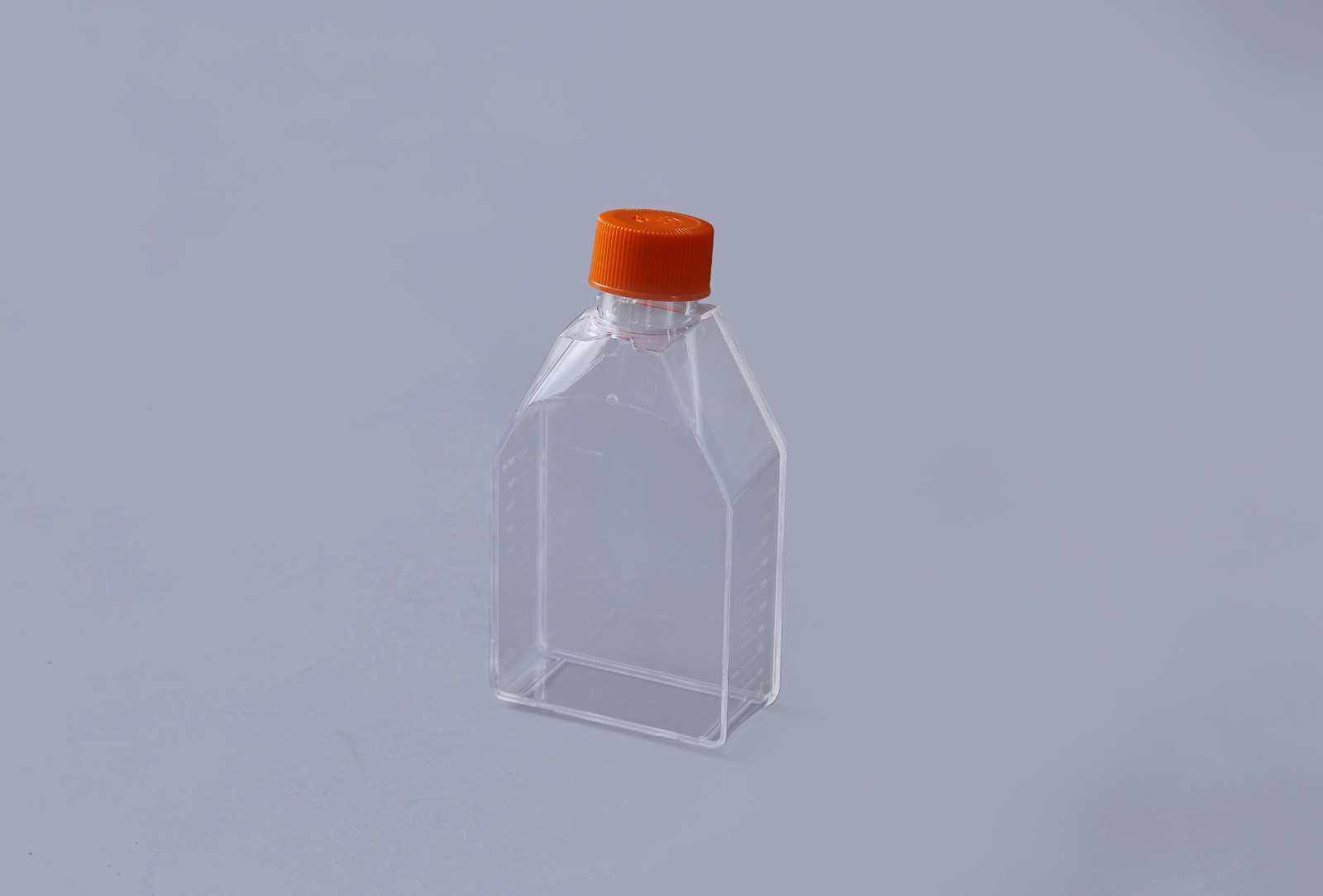The control of angiogenesis is essential in disease treatment or regenerative medicine. We conducted a clinical study of dedifferentiated fat (DFAT) cells, a kind of mesenchymal stem cells, by applying cell transplantation therapy to induce angiogenesis in patients with severe ischemic disease. This study aimed to analyze the effect of molecules that regulate angiogenesis in vitro and clarify their molecular mechanisms for therapeutic purposes. Normal human umbilical venous endothelial cells (HUVECs) were cultured in the presence of vascular endothelial growth factor (VEGF). Recombinant human angiopoietin-1-producing cells, conditioned media, mouse DFAT cells, and antioxidant polyphenols were added to this system at various concentrations. After 11 days, the cultures were immunostained with CD31 (PECAM-1), and microscopic images were subjected to analysis (area, length, joint, and path) by using software to quantitatively analyze blood vessel formation. The expression of angiogenic markers and COX pathway genes were analyzed by RT-PCR. As a result, the dose-dependent angiogenesis-promoting effect of rAng-1-producing cells, conditioned medium, or commercially available recombinant Ang-1 were observed. DFAT cells also promoted angiogenesis, whereas polyphenols inhibited angiogenesis in a dose-dependent manner.

血管生成的控制在疾病治疗或再生医学中是必不可少的。我们通过应用细胞移植疗法诱导严重缺血性疾病患者的血管生成,对去分化脂肪 (DFAT) 细胞(一种间充质干细胞)进行了临床研究。本研究旨在分析体外调节血管生成的分子的作用,并阐明其用于治疗目的的分子机制。在血管内皮生长因子 (VEGF) 存在下培养正常人脐静脉内皮细胞 (HUVEC)。将产生不同浓度的重组人血管生成素 1 细胞、条件培养基、小鼠 DFAT 细胞和抗氧化多酚添加到该系统中。11 天后,用 CD31 (PECAM-1) 对培养物进行免疫染色,通过软件对显微图像进行分析(面积、长度、关节、路径),对血管形成进行定量分析。通过RT-PCR分析血管生成标志物和COX通路基因的表达。结果,观察到了产生 rAng-1 的细胞、条件培养基或市售重组 Ang-1 的剂量依赖性血管生成促进作用。DFAT 细胞还促进血管生成,而多酚以剂量依赖性方式抑制血管生成。或可商购的重组Ang-1被观察到。DFAT 细胞还促进血管生成,而多酚以剂量依赖性方式抑制血管生成。或可商购的重组Ang-1被观察到。DFAT 细胞还促进血管生成,而多酚以剂量依赖性方式抑制血管生成。
2.1. Materials
Normal human umbilical vein endothelial cells (HUVECs) were purchased as an angiogenesis kit (Kurabo, Osaka, Japan; KZ-1000). Human rAng-1-producing 107-35 CHO cells were made by NN. DFAT-D1 cells were established from mature adipocytes of adult ddY mice [31].
Polyphenols apigenin and luteolin (Fujifilm Wako Chemicals) were dissolved in methanol, resveratrol, and quercetin (Fujifilm Wako Chemicals) dissolved in ethanol. Recombinant Ang-1 protein was purchased from R&D Systems. CD31 antibody (tube formation indicator), VEGF-A (positive control), and suramin (negative control) were purchased from Kurabo.
2.2. Angiogenesis Assay
HUVECs were cultured according to the manufacturer’s instructions. Briefly, HUVECs were co-cultured with normal human dermal fibroblasts at an optimal concentration in angiogenic medium-2 (Kurabo KZ-1500) on a 24-well plate. Promotive control VEGF-A (10 ng/mL), inhibitory control suramin (50 μM) or test materials such as cells or a conditioned medium or molecules were added to each well and cultured in a 5% CO2 incubator at 37 °C. In the presence of 10 ng/mL VEGF-A, 8.0, 4.0, 2.0, 1.0 × 105 cells/mL 107-35 CHO or DFAT cells were added and directly co-cultured. Alternatively, 200, 150, 100, and 50 µL/mL of the culture supernatant of 107-35 CHO cells (DMEM + 10% FBS + 1% PS culture for 3 days) or commercially available rAng-1 800, 400, 200, and 100 ng/mL was added to the culture.
To test the effect of polyphenols and flavonoids on angiogenesis, 2.0, 1.0, 0.50, and 0.25 μM apigenin, or 20, 10, 5.0, 2.5 μM luteolin, quercetin or resveratrol were added to the wells.
正常人脐静脉内皮细胞(HUVEC)作为血管生成试剂盒(Kurabo,Osaka,Japan;KZ-1000)购买。产生人 rAng-1 的 107-35 CHO 细胞由 NN 制备。DFAT-D1 细胞是从成年 ddY 小鼠的成熟脂肪细胞建立的。
多酚芹菜素和木犀草素(Fujifilm Wako Chemicals)溶解在甲醇中,白藜芦醇和槲皮素(Fujifilm Wako Chemicals)溶解在乙醇中。重组 Ang-1 蛋白购自 R&D Systems。CD31 抗体(管形成指示剂)、VEGF-A(阳性对照)和苏拉明(阴性对照)购自 Kurabo。
2.2. 血管生成分析
根据制造商的说明培养 HUVEC。简而言之,将 HUVEC 与正常人真皮成纤维细胞以最佳浓度共培养在 24 孔板上的血管生成培养基 2(Kurabo KZ-1500)中。将促进对照 VEGF-A (10 ng/mL)、抑制对照苏拉明 (50 μM) 或测试材料(如细胞或条件培养基或分子)添加到每个孔中,并在 5% CO 2培养箱中于 37°C 下培养。在 10 ng/mL VEGF-A 存在下,添加 8.0、4.0、2.0、1.0 × 10 5细胞/mL 107-35 CHO 或 DFAT 细胞并直接共培养。或者,200、150、100 和 50 µL/mL 的 107-35 CHO 细胞培养上清液(DMEM + 10% FBS + 1% PS 培养 3 天)或市售 rAng-1 800、400、200,并向培养物中加入 100 ng/mL。为了测试多酚和类黄酮对血管生成的影响,将 2.0、1.0、0.50 和 0.25 μM 芹菜素,或 20、10、5.0、2.5 μM 木犀草素、槲皮素或白藜芦醇添加到孔中。

T75细胞培养瓶
This study aimed to quantitatively analyze the effects of molecules that promote or suppress angiogenesis and clarify the mechanism for its regulation. Based on the results of numerical image analyses, the effects of Ang-1 and polyphenols on vascular tissue formation were examined. As a result, we could clarify the concentration-dependent angiogenesis-promoting effect of Ang-1 and the concentration-dependent angiogenesis-suppressing effect of four types of polyphenols. On the other hand, a co-culture with DFAT cells also showed an angiogenesis-promoting effect. We would like to apply the control of angiogenesis by the factors clarified in this study and apply it in regenerative vascular medicine.
本研究旨在定量分析促进或抑制血管生成的分子的作用并阐明其调控机制。基于数值图像分析的结果,研究了 Ang-1 和多酚对血管组织形成的影响。结果,我们可以阐明Ang-1的浓度依赖性血管生成促进作用和四种多酚的浓度依赖性血管生成抑制作用。另一方面,与 DFAT 细胞的共培养也显示出促进血管生成的作用。我们希望通过本研究阐明的因素控制血管生成,并将其应用于再生血管医学。
HUVEC,血管生成,Ang-1,血管内皮生长因子,类黄酮,多酚HUVECs,angiogenesis,Ang-1,VEGF,flavonoid,polypheno,DFAT
来源:MDPI https://www.mdpi.com/2079-7737/10/11/1212/htm














上一篇: 培养基瓶可以用来盛装哪些溶液
下一篇: 为什么要在细胞转瓶内壁包被胶原蛋白